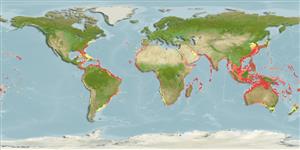Common names from other countries
分類 / Names
共通名の | 類義語 | Catalog of Fishes(部類, 種) | ITIS | CoL | WoRMS | Cloffa
Issue
Chinese common names from Ref. 31517 should correspond to the different species names seen in the book.
Environment: milieu / climate zone / depth range / distribution range
生態学
海; 汽水性の 関連する礁; 深さの範囲 10 - 219 m (Ref. 9710), usually ? - 40 m (Ref. 5288). Subtropical; 43°N - 50°S, 88°W - 154°W (Ref. 57378)
Eastern Atlantic: off the African coast, from Senegal to Southwest Africa, with a single record from St. Helena. Western Atlantic: off the coast of New Jersey (USA), Bermuda, Bahamas, Gulf of Mexico and throughout the island groups of the Caribbean to the southernmost coast of Brazil. Indo-Pacific: Red Sea and the East African coast to the Society and Hawaiian islands, north to Japan, south to Australia and New Zealand.
Not in Eastern Pacific (Ref. 123477 ver. 09Nov2021).
サイズ / 重さ / 年齢
Maturity: Lm ? range ? - ? cm
Max length : 25.0 cm TL オス/雌雄の選別がない; (Ref. 48635); common length : 10.0 cm TL オス/雌雄の選別がない; (Ref. 3585); 最大公表体重: 32.90 g (Ref. 118626)
背面の脊椎 (合計) : 3; 背鰭 (合計) : 11 - 12; 肛門の骨: 0; 臀鰭: 7. Diagnosis: body short and globose; mouth large with many small, villiform teeth; skin rough, covered with bifurcate dermal spinules; pectoral-fin lobes attached to sides of body; illicium at most as long as second dorsal-fin spine; head, body and fins entirely covered with rough, parallel, dark streaks (Ref. 57225).
Inhabit rocky and coral reefs, on rocks, sand or rubble (Ref. 9710). Found in weedy estuaries along the east coast of southern Africa (Ref. 4113). Occurring in marine or brackish waters (Ref. 57225). In the Atlantic, it is found at an average depth of 40 m (Ref. 5288). Benthic (Ref. 58302). Observed to inflate itself greatly like the puffers (Ref. 5521). Oviparous. Males have more intense coloration and extended cutaneous appendages than females (Ref. 205). Eggs are bound in ribbon-like sheath or mass of gelatinous mucus called 'egg raft' or 'veil' (Ref. 6773).
Life cycle and mating behavior
Maturities | 繁殖 | Spawnings | Egg(s) | Fecundities | 幼生
Oviparous. Males have more intense coloration and extended cutaneous appendages than females (Ref. 205). Eggs are bound in ribbon-like sheath or mass of gelatinous mucus called 'egg raft' or 'veil' (Ref. 6773).
Pietsch, T.W. and D.B. Grobecker, 1987. Frogfishes of the world. Systematics, zoogeography, and behavioral ecology. Stanford University Press, Stanford, California. 420 p. (Ref. 6773)
CITES (Ref. 128078)
Not Evaluated
Human uses
水産業: 興味がない; 水族館・水槽: 商業
用具
特記事項
XMLをダウンロードして下さい
インターネットの情報源
Estimates based on models
Preferred temperature (Ref.
115969): 18.2 - 28.6, mean 27 (based on 287 cells).
Phylogenetic diversity index (Ref.
82804): PD
50 = 0.5005 [Uniqueness, from 0.5 = low to 2.0 = high].
Bayesian length-weight: a=0.01995 (0.00906 - 0.04395), b=3.01 (2.83 - 3.19), in cm Total Length, based on all LWR estimates for this body shape (Ref.
93245).
栄養段階 (Ref.
69278): 4.2 ±0.7 se; based on diet studies.
回復力 (Ref.
120179): 高い, 15か月以下の倍増期間の最小個体群 (Fec = 73,000).
Fishing Vulnerability (Ref.
59153): Low vulnerability (15 of 100).
